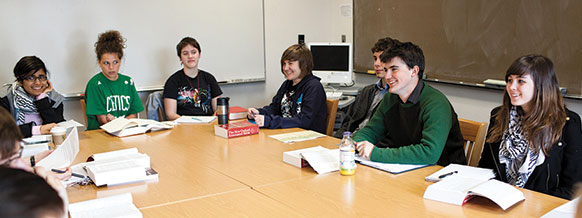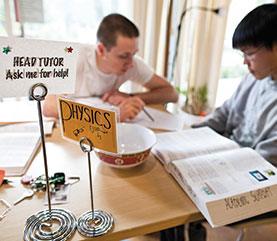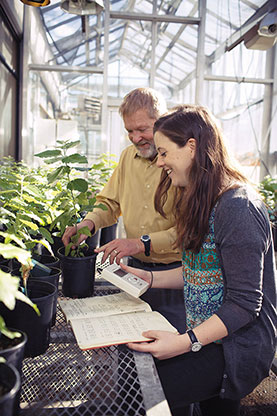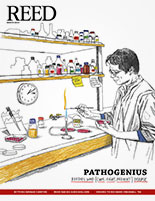
IRIS login | Reed College home Volume 92, No. 1: March 2013
You Did It! (continued)

“The Centennial Campaign’s goals, developed by the faculty, energized the entire Reed community around strengthening Reed. It was heartening to see alumni step up with important leadership joined by our other friends.”
—Hugh Porter [vice president for college relations]
“The day I received my financial aid letter from the college was one of the happiest days of my life; I remember sitting at a coffee shop with a friend. When I got the news that my parents would be able to send me to Reed, I stood straight up on my chair, fists in the air, and screamed ‘Yes!’”
—Tristan Nieto ’13
COMMUNITY
Throughout its history, students and faculty have been drawn to Reed by the promise of finding others who share their passion for knowledge. They seek colleagues who will challenge their understanding of the world and who, in the process, will become lifelong friends.
To create a genuine learning community, Reed must be able to attract and support students representing the broadest possible range of viewpoints, backgrounds, and life experiences. Many of these students cannot hope to attend Reed without financial assistance to help meet the cost. Through the campaign, Reed’s budget has been able to keep pace with rapidly growing need from continuing students and has allowed the college to fully fund the financial need of all entering students.


$74,388,424
Amount raised for financial aid, blasting through the original goal of $50 million. This was by far the largest single category of the campaign.
50%
Proportion of students on financial aid in 2012–13. In an economic climate where families’ needs intensified, Reed maintained its high level of support and kept its promise that no student should ever drop out of Reed because their family ran out of money.
$36,625
Average financial aid package in 2012–13. In addition, the average graduating debt for the class of ’12 was $19,407, compared to a national average of $26,600. [This figure includes federal and state grants, loans and work study, and outside scholarships.]
$21.9 million
Reed’s annual financial aid budget, up from $13.9 million in 2005–06. [This figure does not include federal and state grants, loans and work study, or outside scholarships.]
$65,176
Median parental income of students on aid.
25.3%
Proportion of the student body composed of historically underrepresented groups (i.e. African American, Hispanic, Native American, Asian, and Pacific Islander). Was 13.7% in 2004.
[This figure does not include
international students.]
19%
Proportion of Reed students who qualify for Pell Grants, federal aid that supports the neediest students from low-income families. Up from 14% at the start of the campaign.
66%
Proportion of the freshmen starting in 2008 who graduated within four years. By contrast, those who began in 2004 had a four-year graduation rate of 59%.
893
Students who now live on campus thanks to five dorms built during the campaign. Studies show a direct correlation between living on campus and graduating on time. In 2004 the figure was 743.
"For the first time in my life I feel challenged and engaged intellectually. Since my childhood, I’ve searched for a place like this and, thanks to [a community of donors] I am able to attend. Thank you so very much.”
—Grant Burgess ’13
“I wake up every day joyous and grateful for the direction my life has taken and it is, quite literally, only possible because of your generosity. So although these two words seem insufficient, they are written with my deepest sincerity: Thank you.”
—Serra Shelton ’15
- Previous Page
- 1
- 2
- Next Page


LATEST COMMENTS
steve-jobs-1976 I knew Steve Jobs when he was on the second floor of Quincy. (Fall...
Utnapishtim - 2 weeks ago
Prof. Mason Drukman [political science 1964–70] This is gold, pure gold. God bless, Prof. Drukman.
puredog - 1 month ago
virginia-davis-1965 Such a good friend & compatriot in the day of Satyricon...
czarchasm - 4 months ago
John Peara Baba 1990 John died of a broken heart from losing his mom and then his...
kodachrome - 7 months ago
Carol Sawyer 1962 Who wrote this obit? I'm writing something about Carol Sawyer...
MsLaurie Pepper - 8 months ago
William W. Wissman MAT 1969 ...and THREE sisters. Sabra, the oldest, Mary, the middle, and...
riclf - 10 months ago